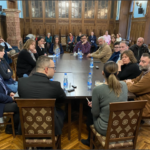The Jewish community of Subotica took over the second-prized work at the Szeged competition for the construction of the Synagogue. The synagogue was built in 1903 in the Hungarian Art Nouveau style. It was built according to the projects of the Budapest architects Marcell Komor and Dezső Jakab, who are also the architects of the Subotica City Hall and spa facilities in Palić.
Funds for the construction of the Synagogue and accompanying buildings around it were collected by selling seats in the future Synagogue and bonds. Those were limited funds, so compared to Szeged synagogue that has an similar number of seats, the construction of the Subotica Synagogue was five times cheaper. Luckily, the architectural and artistic value is not proportional to the funds spent, so Subotica Synagogue leads in architectural language, simplicity and purity of artistic expression.
The act of opening the Synagogue was not only a holiday for the Jewish community, but for the entire city. Writing many years later about the construction of the Synagogue, it was said that the ambition of the Jewish community was not to build only a place of worship, but a temple-palace that would be a monument to the community, but also a building that would adorn the city.
The synagogue could accommodate 1400 worshipers, 850 men on the ground floor and 550 women on the gallery. Data that speaks of its size is the height of the interior space, 23 meters, and the span of the dome, 12.6 meters. The external height of the building is 40 meters. The stained glass windows were made in the studio of Miksa Roth in Budapest, and the facade and flour tiles in the Zsolnay ceramics factory in Pecs, Hungary. Typical of the Hungarian Art Nouveau variant, floral decoration in the form of peacock feathers and stylized flowers can be found on facades, stained glass windows, furniture and painted walls.
The avant-garde values of the Subotica Synagogue’s construction, the use of new materials and technology, as well as the superior permeation of its function and form should also be emphasized. The interior space, conceived as a tent, was associated with Old Testament times, and the bright harmony of colors in the interior of the synagogue was awakening a feeling of joy in the believers.
After the Second World War, the small number of survived Subotica Jews could neither fill nor maintain this venue. Therefore, in 1979, the Jewish Community of Subotica handed over the Synagogue to the City, with the obligation to restore it and use it for cultural programs.
It can be said that during forty years, repairs have been carried out on the Synagogue with minor or major interruptions, but the last comprehensive, very complex, external and internal restoration was completed in December 2017.
The renovated synagogue was ceremoniously re-opened on March 26, 2018, and the Torah bringing i.e. re-dedication ceremony was held on May 7, 2018.
Today, the synagogue has retained its religious function. Religious services are occasionally held there while otherwise they are held in the so-called “small” synagogue that is located in the building of the Jewish Community. The renovated synagogue is also a concert venue. The most attractive programs held in the synagogue are within the “Autumn Festival of Jewish Culture” organized by the Jewish Community of Subotica. Last but not least, the synagogue is open for tourist visits every day except Mondays and holidays.



